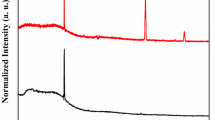Abstract
In this present study, a fixed-mattress column adsorption device was transformed into implemented. The pH Point of Zero Charges (pHPZC), Scanning Electron Microscopy (SEM) and BET surface area examination had been carried through for adsorbent to demonstrate the techniques of significant reduction of fluoride by absorption. On the whole functioning, the column was assessed at usual space heat, a constant initial concentration, and bed level. The highest breakdown capability of 71.97 mg/kg was transformed into accomplished for DE at particle sizes of 1 mm, 850 µm, 600 µm, and 500 µm respectively. The Bradley equation is used to determine the isothermal information and, a dose that is an adsorbent. The statistical analyses were done Langmuir that is using and equations until isotherm studies had been carried out. To investigate the adsorption process, two simplified kinetic models were used. A series of experiments were conducted using diatomaceous earth in raw form, as received from mines and activated form for the adsorption of fluoride ions present in water. This experiment shows that the diatomaceous earth clay works as a filtration media for the elimination of 20.73% fluoride from water. The fluoride removal potential that is the majority of 71.97 mg/kg was found into DE at particle dimensions of 850 mm. Pre-heated diatomaceous earth clays were highly active to form a complex with fluoride. Adsorption through less heated diatomaceous earth had been less significant. There was a slight change in pH, it would increase by 0.1% in the sample while there was negligible change in TDS of water after adding activated absorbent. This paper depicts the fluoride elimination from treated wastewater and groundwater that can be accomplished with the aid of using diatomaceous earth clay. The absorbance convenience of DE is 20.73% when utilized as being filtration materials. While 71.97%, when activated diatomaceous earth clay, is used as a sorbent.
Access this chapter
Tax calculation will be finalised at checkout
Purchases are for personal use only
Similar content being viewed by others
References
Adeyemo AA, Adeoye IO, Bello OS (2017) Adsorption of dyes using different types of clay: a review. Appl Water Sci 7:543–568. https://doi.org/10.1007/s13201-015-0322-y
Anthony IA, Gitari MW, Gumbo RJ (2016) Desalination and Water Treatment 36:16745–16757
Aoudj S, Khelifa A, Drouiche N (2017) Removal of fluoride, SDS, ammonia and turbidity from semiconductor wastewater by combined electrocoagulation–electroflotation. Chemosphere 180:379–387. https://doi.org/10.1016/j.chemosphere.2017.04.045
Berger T, Mathurin F, Drake H, Åström M (2016) Fluoride abundance and controls in fresh groundwater in quaternary deposits and bedrock fractures in an area with fluoride-rich granitoid rocks. Sci Total Environ 569–570:948–960. https://doi.org/10.1016/j.scitotenv.2016.06.002
BIS (Bureau of Indian Standards) (2012) Specification for drinking water IS 10500:2012, New Delhi
Cherukumilli K, Maurer T, Hohman J, Mehta Y, Gadgil A (2018) Effective remediation of groundwater fluoride with inexpensively processed Indian bauxite. Environ Sci Technol 52. https://doi.org/10.1021/acs.est.7b05539
Dhillon A, Sapna, Kumar D (2017) Dual adsorption behavior of fluoride from drinking water on Ca-Zn(OH)2CO3 adsorbent. Surf Interf 6:154–161
Ece UD, Ceyhun A, Çağdaş G, Yasin Ö (2019) Enhancing treatability of tannery wastewater by an integrated process of electrocoagulation and fungal via using RSM in an economic perspective. Process Biochem 84:124–133. https://doi.org/10.1016/j.procbio.2019.06.016
Godboley B, Nagarnaik P (2016) Groundnut shell: effective adsorbent for defluoridation from aqueous solution 7:51–60
Hamamoto S, Kishimoto N, Ueki M (2015) Mechanistic consideration of fluoride removal using aluminum sulfate. J Water Environ Technol 13:15–24
He Z, Zhang G, Xu W (2013) Enhanced adsorption of fluoride from aqueous solution using an iron-modified attapulgite adsorbent. Water Environ Res A Res Publ Water Environ Fed 85:167–174. https://doi.org/10.2175/106143012X13560205144218
Kır E, Oruc H, Kır I, Sardohan-Koseoglu T (2016) Removal of fluoride from aqueous solution by natural and acid-activated diatomite and ignimbrite materials. Desalin Water Treat 57:21944–21956
Kumar P, Gupta P (2021) DE Fluoridation of domestic waste water by using activated diatomaceous earth in fixed mattress column adsorption system. Oriental J Chem 37(3):594–601. https://doi.org/10.13005/ojc/370311
Kumar SP, Yesha A, Kaliaperumal S (2014) Defluoridation using biomimetically synthesized nano zirconium chitosan composite: kinetic and equilibrium studies. J Hazard Mater 276:232–240. https://doi.org/10.1016/j.jhazmat.2014.05.038
Mishra KU, Siddiqi A, Meikap H (2020) J Cleon Prod 381:120917
Mishra KU, Siddiqi A, Meikap H (2021) J Cleon Prod 279:123645
Nehra S, Raghav S, Kumar D (2020) Biomaterial functionalized cerium nanocomposite for removal of fluoride using central composite design optimization study. Environ Pollut 113773. https://doi.org/10.1016/j.envpol.2019.113773
Ngulube T, Gitari MW, Tutu H (2016) Defluoridation of groundwater using mixed Mukondeni clay soils. Water Sci Technol 17:480–492
Prathibha C, Sharma B, Chunduri LAA, Aditha SK, Rattan TM, Venkataramaniah K (2015) Nano calcium-aluminum mixed oxide: a novel and effective material for defluoridation of drinking water. Sep Sci Technol 50:1915–1924
Rabelani M, Mugera WG, Segun AA, Titus A, Makudali M (2017) Synthesis and physicochemical characterization of MnO2 coated Na-bentonite for groundwater defluoridation: adsorption modeling and mechanistic aspect. Appl Surf Sci 422:745–753. https://doi.org/10.1016/j.apsusc.2017.05.194
Roy S, Das P, Sengupta S (2017) Thermodynamics and kinetics study of defluoridation using Ca-SiO2-TiO2 as adsorbent: column studies and statistical approach. Korean J Chem Eng 34:179–188
Steier L, Steier R, Steier G (2016) Intersections of dental health and food law: the conflict of systemic fluoridation as a public health instrument to prevent tooth decay. Int Food Law Policy 291–318. https://doi.org/10.1007/978-3-319-07542-6_13
Subbaiah MP, Natrayasamy V, Sankaran M (2014) Defluoridation of water using chitosan assisted ethylenediamine functionalized synthetic polymeric blends. Int J Biol Macromol 70:621–627. https://doi.org/10.1016/j.ijbiomac.2014.07.016
Swapnila R, Shubhalakshmi S, Papita D (2017) Integral approach of adsorption and chemical treatment fluoride-containing wastewater: batch and optimization using RSM. J Environ Chem Eng 5(1):274–282. https://doi.org/10.1016/j.jece.2016.12.003
Tsuzuki T, McCormick PG (2004) Mechanochemical synthesis of nanoparticles. J Mater Sci 39:5143–5146. https://doi.org/10.1023/B:JMSC.0000039199.56155.f9
Uddin MK, Salah MM (2018) Statistical analysis of Litchi Chinensis adsorption behavior toward Cr(VI). Appl Water Sci 8:140. https://doi.org/10.1007/s13201-018-0784-9
WHO guideline for drinking water (2011) 4th ed, Geneva 978:154815
Wu L, Zhang G, Tang D (2016) A novel high efficient Mg–Ce–La adsorbent for fluoride removal: kinetics, thermodynamics and reusability. Desalin Water Treat 57:23844–23855
Yu X, Chen J, Li Y, Liu H, Hou C, Zeng Q, Cui Y, Zhao L, Li P, Zhou Z, Pang S, Tang S, Tian K, Zhao Q, Dong L, Xu C, Zhang X, Zhang S, Liu L, Wang A (2018) Threshold effects of moderately excessive fluoride exposure on children’s health: a potential association between dental fluorosis and loss of excellent intelligence. Environ Int. https://doi.org/10.1016/j.envint.2018.05.042,118,(116-124)
Zhang S, Lyu Y, Su X, Bian Y, Yu B, Zhang Y (2016) Removal of fluoride ion from groundwater by adsorption on lanthanum and aluminum loaded clay adsorbent. Environ Earth Sci 75:401
Acknowledgements
The authors convey gratitude to SUNRISE University Alwar, Rajasthan (India), and Dr. Pankaj Gupta sir for their guidance and support.
Conflicts of Interest
None.
Author information
Authors and Affiliations
Corresponding author
Editor information
Editors and Affiliations
Rights and permissions
Copyright information
© 2022 The Author(s), under exclusive license to Springer Nature Switzerland AG
About this paper
Cite this paper
Kumar, P., Gupta, P. (2022). Reduction of Fluoride from Domestic Waste Water by Using Activated Diatomaceous Earth. In: Ratan, J.K., Sahu, D., Pandhare, N.N., Bhavanam, A. (eds) Advances in Chemical, Bio and Environmental Engineering. CHEMBIOEN 2021. Environmental Science and Engineering. Springer, Cham. https://doi.org/10.1007/978-3-030-96554-9_59
Download citation
DOI: https://doi.org/10.1007/978-3-030-96554-9_59
Published:
Publisher Name: Springer, Cham
Print ISBN: 978-3-030-96553-2
Online ISBN: 978-3-030-96554-9
eBook Packages: Chemistry and Materials ScienceChemistry and Material Science (R0)




